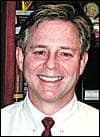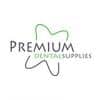by Sarah Schmelling
A high-tech renovation empowers Thomas Marcel, DDS, to treat 100 patients per day

“The practice just continues to grow,” he says, explaining that he opened the practice with four employees 12 years ago, and now has 17, including an associate for 1.5 days each week. “And as the number of patients seeking my services has increased, there’s a challenge to not just maintain standards, but also to improve them and try to get better results.”
Marcel, based in Livermore, Calif, says he has been able to face this challenge through the creation of a completely computer-based, paperless office, which he remodeled last summer. The building, which he expanded from 2,000 to close to 4,000 square feet, is complete with, among other features, flat-screen televisions above all 8 chairs, a dedicated computer room, and a lecture hall, where he can share information with visiting residents and staff members.
|
|||
| Patients Per Day: | 100-120 | ||
| Office Square Footage: | 3,900 | ||
| Staff Members: | 17 | ||
| Years in Practice: | 14 | ||
| Workdays Per Week: | 4 patient days (Friday is an administrative day) | ||
| Specialty: | Orthodontics | ||
The technology extends not only to his clinical practice, but also to patients, who are now able to securely access their records and confirm appointments online. Marcel uses digital signature pads for every patient chart, and advanced electronic patient scheduling ensures that every minute of his day is accounted for.
Using all of this technology may seem like a leap, he says, but it’s been well worth it. “I think if your office sends the message of being high-tech, that reflects favorably on what you’re trying to achieve clinically,” he says.
But being paperless is just one part of Marcel’s practice philosophy. His ideas of what makes a great orthodontic experience for patients stretch from scheduling efficiently, to utilizing the latest advances in care, to having every member of his team stay as knowledgeable as possible.
Going Paperless

Marcel’s staff began implementing the system in 1996, but didn’t change over all at once.
“I chose to do it over a period of 2 years,” he explains. “Any new patient record made after a particular date became an electronic chart. So over that period of time, you’re pulling fewer charts, more of them become electronic, and then basically your whole practice is converted over.”
The office utilizes a specialized Internet management software product that allows the staff to upload all electronic records to a secure Web site.
“This way, you can communicate with referring dentists much more easily,” Marcel says. “So if I need an oral surgeon to have a tooth extracted, my request can be uploaded immediately, before the patient has even left our office. Then, when the patient calls that other specialist’s office to make an appointment, they already know what’s needed.”
Marcel also uses the system for communication among multiple specialists for cases that require, for example, a periodontist, a surgeon, and a dentist to work together. “It’s very difficult to schedule meetings for these kinds of cases,” he says. “This way, we can all view the records sitting in our own offices, email our thoughts and questions to each other throughout the day, and, a lot of times, expedite that patient’s care.”

The Web site also allows patients to view their upcoming appointment times and financial histories, and even pay bills online.
Technology also plays an important part in scheduling those 100+ patient visits every day. “We are maniacal when it comes to scheduling. It is imperative that we run on time,” Marcel says. “Patients do not wait in our office.”
When patients arrive, he explains, they check in using a computer that records what time the appointment was scheduled for, when the patient arrived, and how long they’ve been waiting. “Their name is color coded; so if it’s pink, that means we are past their appointment time,” he says. “If it’s red, they’re 5 minutes past their appointment time, and we need to make adjustments in our schedule to get that patient seen right away.”
He says that patients—and their parents—learn the system very quickly. If they’re 15 minutes late for a 20-minute appointment, they are asked if they want to wait until there is another opening, or if they want to reschedule. “Mom only needs to hear that once, and she understands that you need to be on time,” he says.
When it comes to his clinical orthodontic work itself, Marcel also strives to stay on the cutting edge. His treatment options include clear plastic aligners and lingual braces, as well as ligature-less brackets. He’s also so excited about the 3-D cone-beam radiological technology that will be available in the next few years that he has made space for a machine that can do this kind of diagnostic work within the remodeled office.
A New Environment
For Marcel, changing the office wasn’t just about increasing square footage. It once again came back to the importance of efficiency. For example, the renovation allowed Marcel to add a more comprehensive records area, an x-ray room, and a computer room—something he says was very important.
“Before [the renovation], our server lived in the lab, and it was not a good environment, with all the dust and foot traffic,” he says. “Now, we’ve got a room that is clean and has its own climate control. There’s a workstation, so diagnostics can be done by our tech team, and it has enough space that it’s expandable—so if we need to add servers or backup drives, we have room to expand our computing capabilities.”
There’s also an extensive new audio/video layout to the office, Marcel says. In addition to the monitors above the chairs, there are plasma screens on the walls where the staff can show everything from Disney movies to high-definition sporting events.
Even the move itself had a forward-thinking plan behind it. The construction work began while the staff was still in the office. Then, when they needed to move to a temporary office across town, the tech support team set up a wireless network so that the staff was only required to move the server, the x-ray machine, and their wireless laptops.
“Our patient charts and our schedule were accessible immediately,” Marcel says. “We didn’t have to move 8,000 charts; we didn’t have to file anything. We stopped seeing patients on a Thursday, equipment was moved on a Friday, each team picked up what they needed chairside, and we were seeing patients Monday morning.”
Then, 7 weeks later, the same process was used to move back into the renovated office.
Thirst for Knowledge
Having received his orthodontic training at the nearby University of California at San Francisco, Marcel now lectures there, as well as at the University of the Pacific and through a University of North Carolina program that brings residents to the Bay Area for short-term, in-practice education. It’s an activity he truly loves.
“I think being in practice over 10 years you have something to offer, and your experience is beneficial to residents,” he says. “It’s fun for me to get them enthusiastic about business, marketing, and other parts of orthodontics that you don’t really get when you’re in a residency.”
This desire to share knowledge spreads more directly to Marcel’s staff, to whom he provides seminars at least once a month. “Training the staff in orthodontics is only going to improve their skills, improve their communication with patients, and [help them] anticipate what my clinical decisions are,” he says. “So we routinely schedule training seminars. I block out 2 to 4 hours a month on the schedule, and we have a seminar that’s much like a residency.”
The staff appreciates it, “and I see the results of it in the clinic all the time,” he says, adding that this “team focus” also includes assigning an assistant to follow the same patient throughout his or her treatment.
Marcel encourages his staff to attend industry conferences and continuing-education opportunities whenever possible. “It’s difficult for a doctor to hear everything that’s presented at a scientific meeting, but not if you’ve got 12 or 15 spies out there gathering information for you,” he says. “What we usually do is meet back in a room at 4:00 that afternoon and have a debriefing, and everyone shares a pearl of what they learned that day, and how it may be applicable to our office.”
Making it Work
With all the advanced technology, and the importance placed on education, it is hard not to wonder how this is possible to do financially. But Marcel contends that his processes actually save him money.
“I challenge orthodontists to look at the time spent by staff pulling charts, filing charts, looking for charts that have been misplaced, filing informed consents, filing letters from surgeons, addressing envelopes, printing letters, stamping letters—if you were to quantify that, it would be tremendous,” he says. “The staff time spent on that in dollars per hour is so much more than a $2,000 software program that can do it for you.”
In fact, he says that when he thinks about how easy it was to set up a paperless office, he wonders why he didn’t do it sooner.
“The biggest challenge is getting other offices in your community up to your level,” he adds. “And this takes working with those referral offices, inviting them in, showing them what the technology can do for them, and really encouraging them to work with you in facilitating mutual patient communication.”
Another way to save money while still advancing the practice, he says, is to create a specific marketing plan that involves the entire office. Marcel and his staff sit down every September to evaluate marketing spending over the past year, and to set a budget for the coming one, considering things like what to do for certain holidays and whether past events worked or didn’t.
He adds that a lot of marketing can be done through simply creating a great office environment for patients. “If you really have a ‘wow’ factor in your office, [patients] are going to be more likely to go back to their dentist and say, ‘We love it at Dr Marcel’s office,’” he says. “Then, that referring dentist is going to be more likely to want to work with you more often.”
Still Growing
As for future plans, Marcel says he’s still recovering a bit from last year’s remodeling effort, but he continues to look ahead.
“People ask me, ‘Aren’t you maxed out? Isn’t there a maximum number of patients you can see?’ I say no. I’m always going to be looking for a way to be a little bit better—to deliver better results in a little less time, with a little less effort from the patient’s standpoint,” he says. “So if I can be one percentage point more efficient a year, that’s what I’m going to do, as long as my standards are not compromised.”
He says that for anybody whose business is growing, whether they’re an orthodontist or they sell ice cream, the most important thing is to deliver the highest standard of care or the best product they can.
“Because ultimately, that’s what’s going to grow your business; that’s how your reputation will be established,” he says. “So ways of growing my practice—whether it’s how I put brackets on teeth, or the wires I use, or delegating more to qualified staff people, or utilizing the Web site for marketing, I’m going to be looking for ways of improving every aspect of my business.”
Sarah Schmelling is a contributing writer for Orthodontic Products.





